
India most sacred river saraswati found
For most of the Indians, Saraswati is better known as the divine wise goddess of learning and knowledge -Consort of brahma. Even today, images of goddess saraswati can be found in most Indian school and colleges where the lectures doesn’t start until the prayer is offered to goddess saraswati by students, teachers and college staff. Until now, saraswati was revered as only goddess of knowledge and learning but all is about to change as the history is unfolding itself to felicitate the deep contribution of Vedic sages to Indian glorious civilization.
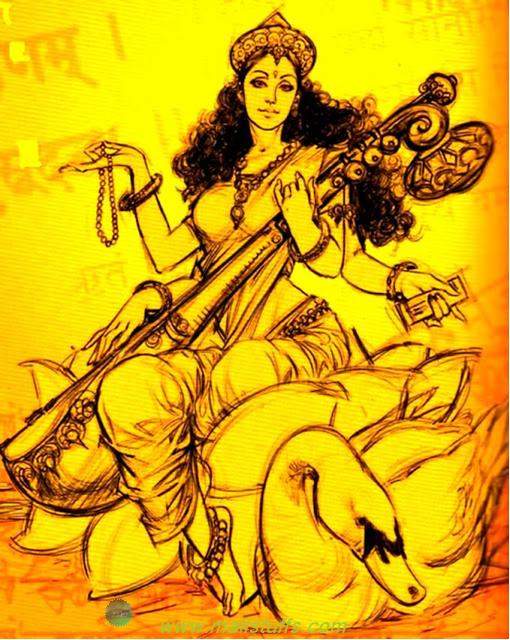
Saraswati, the Goddess of Learning
A section of our scholars, encouraged by the government that favoured British rule, believes in some fictitious, exaggerated, impractical Aryan invasion theory according to which sword-swinging, iron-using, blue-eyed, fair skinned nomadic Aryans riding on their horses invaded India from some western European country. According to this theory, Vedic aaryans defeated indigenous Dravidians (South Indians) and forced them to move southwards. This theory was further supported by Dravidian historians who wanted to represent dravidians as original Indian inhabitants and branded north Indians as foreign, cruel invaders. This Article will not only refute this Aryan invasion theory but would also illustrate the deep intelligence, knowledge and supeiroritiy of Vedic Aryans, thus symbolizing itself as the most advanced civilization of its time.
Recent archaeological excavation and scientific research has concluded the existence of the mighty saraswati river, which as per the Vedic texts, was very sacred and disappeared some 4000 years ago. Through satellite images of NASA and ISRO, scientists and archeaologist have mapped the course of enormous river that flowed from the Himalayas, passing through the north western plains of India and finally merging with the Arabian Sea near the costal region of Gujarat. These images show that at some places, river was 8 to 11km wide and was as long as 3000 km, thus making it one of the biggest and widest rivers of the world.
Today most people in India think saraswati as a mythical river while some belive it as invisible or flowing underground. Another common perception is that Saraswati flowed through the scared city of Allahabad to meet the other two sacred river Ganges and Jamuna. This confluence of three rivers - which is invisible to eye - is considered as holiest of all Indian spiritual places.
Let us validate the research with the texts mentioned in ancient Indian scriptures
Saraswati in the Vedas:
Lifeline of any country is defined by its water sources like rivers, lakes etc. Most of the world greatest civilizations (Mesopotamian, Egyptian, and Chinese) all prospered on banks of mightiest river. Unlike other civilizations, Hindus considers river as sacred, worshipped them as deities and often sung hymns and prayers to glorify them.
One such river is Saraswati, and is glorified in Vedas by several names like Markanda, Hakra, Suprabha, Kanchanakshi, Visala, Manorama etc.
For long, Vedas was considered as a divine mythological text but with the discovery of saraswati, its sacredness and authenticity has increased fourfold.
Rig Vedic verse 3.23.4 describes Sarasvati River as flowing together with the Apaya and the Drasadavti River.
Rigvedic verse describes Sarasvati River as swollen (pinvamânâ) by the rivers (sindhubhih).
While Rigvedic verse 6.61.12 associates Sarasvati River with the five tribes, Rigvedic verse 7.95-6 associates her with the porus and the Paravatas.
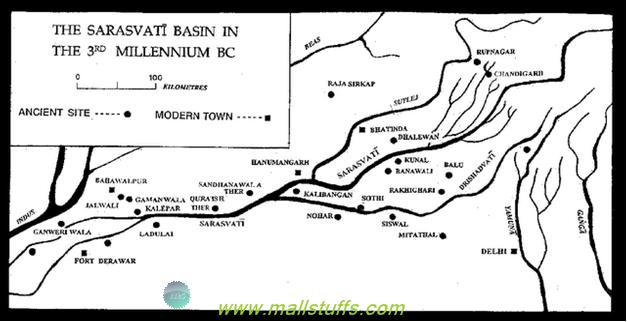
Saraswati of 3rd millennium BC
Rig Vedic Verse 6.61 indicates saraswati emerges from the mountains, with stong waves.
The only mountain in the north with source abundant in water is Himalayas. This makes current hakra-ghaggar river as the best fit to Saraswati River.
Ghaggra river
Rig Vedic Verse 7.36.6 states ‘sarasvati_ saptathi_ sindhu maataa’ which translates as “saraswati is mother of seven rivers”
Other six rivers are Shatadru (Sutlej), Vipasa (Beas), Askini (Chenab), Parsoni or Airavati (Ravi), Vitasta (Jhelum) and Sindhu (Indus).
These rivers still flow today in northern areas of India and Pakistan.
Above information is again said in Rig Vedic verse [6:61:12] as - “Seven sistered, sprung from three-fold sources”.
If there is mention of ten rivers and out of those ten, if nine exists today, then thinking that the tenth did not existed seems very foolish and illogical. I don’t think Vedic sages would mention nine real rivers and one imaginary river. Many mythological magical events are interwined with Saraswati River but the same case is with the ganges.Therefore, rather than refuting the existence of Sarasvati River, one should try to explore the deep poetical thoughts mentioned in the Vedas.
Verse 7.95.2 and verse 8.21.18 mentions about saraswati pouring “Milk and ghee”
Vedic aaryans treated cows as sacred and used milk products heavily in their diet. Since these cows grazed near the saraswati fertile areas and drank water of Saraswati River, saraswati was said as pouring Ghee and milk.
Rig Vedic verse 8.21.18 verse describes a number of petty kings ruling along the course of Sarasvati,
Most of the kingdoms had their capitals near the river banks. Even Dasrath (Father of Ram, Ramayana) and Shantanu (Father of bhisma, Mahabharata) had their kingdom on the banks of river sarayu and Ganga respectively.
Rig Vedic verse 10:64:9, Sarasvati, Sarayu and Sindhu are worshipped as three mighty rivers.
Sarayu as a mighty river is even mentioned in Ramayana and as per the research, sindhu was the mighty river thousands of years ago.
Verse 10.75.5 enumerates all major rivers from the Ganges in the east to the Indus in the west in exact geographical order.
In this verse, prayer is offered to ten rivers including Sarasvati as- “O Ganga, Yamuna, Sarasvati, Sutlej, Ravi, Chenab, Marudvrudha, Jhelam, Sohana and Vyas and other rivers listen to our eulogy”.
All the major rivers mentioned above exist today and saraswati is mentioned as the river flowing between Yamuna and Sutlej, which again implies current river ghaggar of haryana as the best fit to Saraswati River. This is further supported by archaeological and scientific research which we will see later in this article.
Praise similar as above is also found in Rig Vedic verse 6.61.8-13, 7.96, and 10.17
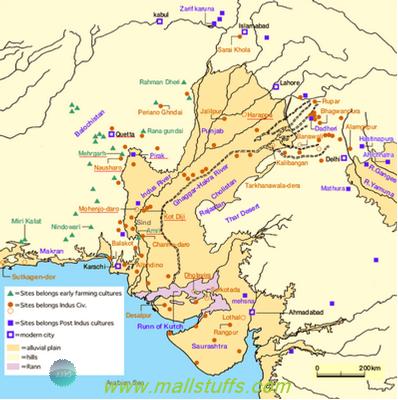
Present ghagra Hakra River
Beside these, rig Veda says the following about Saraswati River
Sarasvati with fostering strong currents is our defense, our fort of iron.
As on a chariot,, the flood flows on, surpassing in majesty and might all other waters.
Pure in her course from mountains to the ocean, water flows on, surpassing in majesty with all other waters.
Below is some of the rig Vedic verse where the river saraswati is worshipped which also signifies “saraswati, not ganga, was the holiest of all rivers”. This is further supported by the fact that Ganga is mentioned only once in rig Veda whereas saraswati is mentioned about sixty times. These verses along with their translation are
"Maho arnah sarasvati pra cetayati ketuna dhiyo visva virajati" means, like a great ocean, sarasvati appears with ray and rules all inspirations.
"ni tva dadhe vara a prthivya ilayspade sudinatve ahnam, Drsadvaty am manuse apayayam sarasvatyamrevad agne didhi" Means “Oh sacred fire, we set you down at the most sacred place on earth, in the land of illa, in clear bright day, On the apaya, drishadvati and the Sarasvati, which shines out brilliantly for men.
"Ayasi puh visva apo mahina sindhur anyah, sucir yati girbhya a samudrat" means sarasvati is like a bronze city way ahead of all other rivers and water bodies, pure in her course from mountains to the sea.
Rishi Gritsamada calls Sarasvati as mother, river and Goddess (ambitame, naditame, devitame sarasvati).
Vedict text doesn’t aways relate saraswati with a river. In some cases, godes saraswati is called as a goddess. In verse 10.17, Sarasvati is called as a goddess of forefathers as well as the present generation. In Rig Vedic verse 1.13, 1.89, 10.85, 10.66 and 10.141, she is worshipped along with other deities and is not call it as a river.
In verse 10.65, she is praised as goddess of goddess of knowledge and fertility.
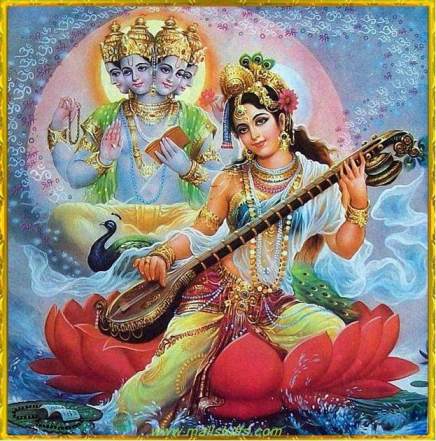
Saraswati as goddess
Yayurveda talks about saraswati being filled by five celebrated rivers. These Five tributaries were Drishadvati, Satudri (Sutlej), Chandrabhaga (Chenab), Vipasa (Beas) and Iravati (Ravi).
During the rig Vedic era (Compiled roughly around 15000 years ago), there was ten rivers while during the compilation of yajurveda (Roughly around 6000 years ago), only five rivers. This indicates the discourse of river saraswati or its tributaries and hence, the drying up of saraswati river.
Saraswati in the puranas
Vamana Purana verse 32.1-4 states Sarasvati rising from the (Pipal tree)
Several Puranas describe the seperation of Sarasvati River into number of disconnected lakes. Skanda purana talk about saraswati flowing through the Himalayas and then turning west at kedara after which it flows underground.
In skanda purana, similar to yaurveda, saraswati is mentioned with only five distributaries Harini, Vjrini, Hyunk, Kapila and Sarasvati.
According to puranic mythology, melting of Himalayas is an outcome of war between demon Vritra and God Indra. Vast enormous use of water for agriculture and other civilized occupation prompted the Vedic aaryan to describe seven mighty rivers as ‘Sapta Sindhu’, which means Divine River coming from slowly moving serpent (Ahi).
Since river sarraswati embraced a civilization on her banks which is confirmed by over 2,000 archealogical evidences, she was called as a mother. Like a loving mother, river Sarasvati nurtured the civilization on its banks and supported a number of ports, spiritual learning centers with innumerable scholars, ascetics, seers and sages. Due of abundance of such divine rishis and scholars, most probably the Vedas was compiled on the banks on river saraswati. Since such a huge pursiuit of divine knowledge, art and learning was nurtured on the banks of river saraswati, Saraswati appropriately was elevated to the status of goddess of knowledge, learning, language, arts and sciences.
Hence the rigveda rightly portrayed saraswati as “surpassing in majesty and might all other water’’ and “pure in her course from mountains to the ocean’’.
From above verse, one cannot deny Himalayan Mountains as the source of saraswati. This agains makes Ghaggar, the intermittent river bwteeen Himalayas and Thar Desert, a best choice of mystic Sarasvati River.
And as said before, Rig Veda talks about saraswati flowing between two other rivers Sutlej and Yamuna, finally merging with the sea. The only river that complies with this verse is Ghaggar-Hakra,as shown in the map below, and further confirmed by the geological evidences.
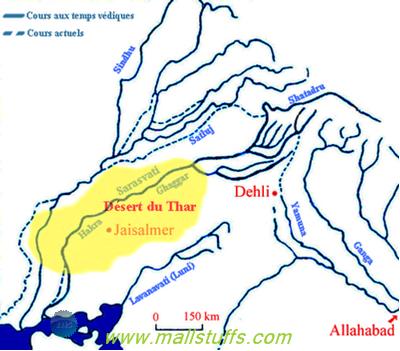
-Kartikey, son of lord shiva, was commemorated as the Commander of Deva forces on the banks of river saraswati.
-Pururava, the descendant of Lunar Dynasty, met his wife Urvashi along the banks of river Saraswati.
-Parshuram, fifth avatar of lord Vishnu, bathed in the waters of river saraswati for purification after cleansing the earth from tyranny of kshatriyas.
Saraswati in the mahabharata
Saraswati is again mentioned in the Mahabharata where it is said that river saraswati flows north of kurushetra battlefield, parallel to the Indus, before falling into the Arabian Sea.
Further, Mahabharata accounts the drying up, disapparearance of the Saraswati River into the desert area near Binasan (Sirsa). After disappearing in the desert, it reappears in some places and joins the sea "impetuously".
One verse also says Saraswati as a non perennial river survining in form of number of lanes i.e. Brahmasar, jyotisar, Kaleswar (in Haryana), Katasar, Pandusar & Ravisar (in Rajasthan).
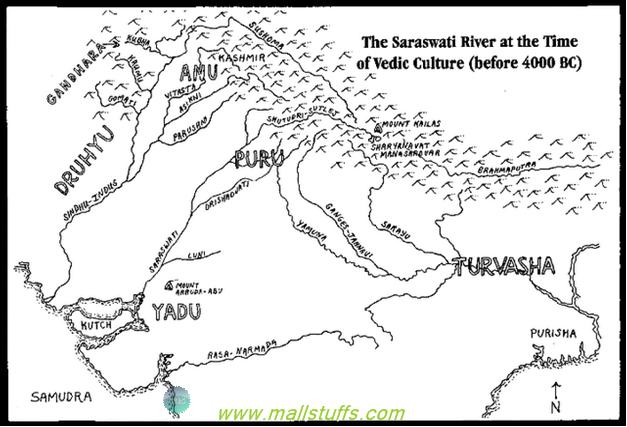
Sarasvati river during the time of mah baharata
Saraswati in Late Vedic Texts
Brahmanas is the first text to mention the disappearance of river saraswati. Jaiminiya Brahmana (verse 2.297) speaks about the 'diving under (upamajjana) of the Sarasvati', and the Tandya Brahmana calls this as 'disappearance' (vinasana) of the saraswati.
Verse (25.10.11-16) says Sarasvati as ‘meandering' (kubjimati) as it could not reach his destination. Tandya Brahmanas (verse. 25.10.16) and Pancavimsa Brahmanas (verse 6.131.3) mention the distance between source and Vinasana (place of disappearance) as 44 asvina (about 1600 miles)
Latyayana Srautasutra (10.15-19), Sarasvati is described to be the perennial river drying up near its western confluence with the Drshadvati while Drshadvati is said as a seasonal stream (10.17). Asvalayana Srautasutra and Sankhayana Srautasutra contain verses confirming the same
In Manu Smriti, the sage Manu , is said to be the founder of vedic culture between the drishadvati and Sarasvati rivers.
Similarly, verse I.8-9 and 12-13 of Vasistha Dharma Sutra describes Aryavarta as the kingdom to the east of disappeared Sarasvati dry beds, to the north of mountain pariyatra, to the west of Kalakavana and Vindhya and to the south of the Himalaya .
Patanjali s Mahâbhâ?ya re-described the verse of Vasistha Dharma Sutra.
Baudhayana Dharmasutra also describes Aryavarta as the land west of Kalakavana ,east of Adarsana(Saraswati Dry beds), south of the Himalayas and north of the Vindhyas .
Evidences of saraswati disappearance
.Even the Nile River- the longest in the world and other rivers are contracting and disappearing day by day. Besides, during the last five to six thousand years, many geographical transformations have happened on earth and so, what we learn from Mahabharata is pure history and not some imaginary novel.
Mahabharta again mentions about Saraswati River by describing Balram (Lord Krishna brother) sacred pilgrimage from Dwarka to Mathura along the drying bed of Saraswati River, to immerse the ashes of the Yadavs after the battle. On his return journey, he visited a number of Sages, ashrams which supports the perception of saraswati being the great center of learning and education.
This also concludes that saraswati was navigable by the time mahbharata war occurred and the epic was written before the drying up of Sarasvati River. Both the astrological dating of mahabharta war (3rd millemnium BC) and carbon dating of Saraswati River dry beds point to the same period of time.
Incidentally, Shrimad Bhagavatam says Balrama, the brother of Shri Krishna, responsible for the change in course of river Yamuna, a major tributary of Saraswati!
This combined with drought, earthquake and other factors led to the disappearance of river saraswati.
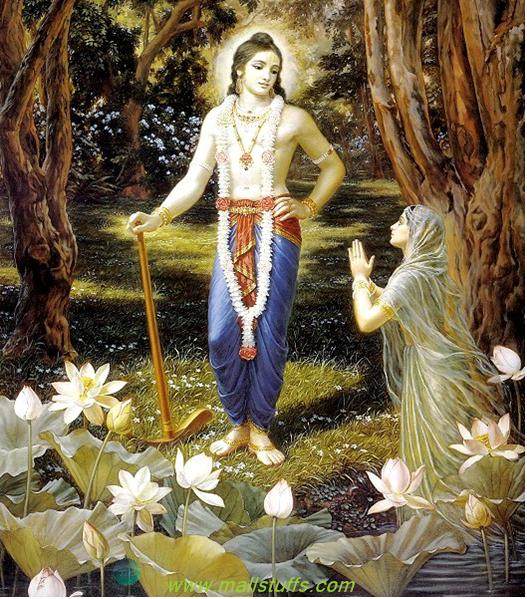
Balrama altering the course of Yamuna!
Also, there are some references to faults and fissures on dry bed of river saraswati. This is the reason why invading mughal rulers marching to delhi took the longer mountainous route instead of shorter saraswati dry bed route because of the difficulties encountered while crossing the fissures on the river saraswati dry bed. Landsat (USA remote sensing satellites) has confirmed the existence of large ground faults in the earthquake prone region of Gujarat and rajasthan, adjoining the Saraswati -Sindhu valley. Though these ground faults, water leaked to underground channels, thus leading to the belief of Vedic Sarasvati flowing underground.
Research on course of saraswati river
Ten thousand years ago, when mighty rivers flowed through the slopes of Himalayas plains, western Rajasthan was highly fertile, lusted with greenery, cool amiable environment. Some 6,000 years later, Saraswati, one of the major rivers for reason stated before, dried up and gradually, the greenery of Rajasthan was lost, replaced by a hot arid, sandy desert
Research for finding disappeared Saraswati River is not something new. Spark of research was first intitiated by a British engineer ‘CF Oldham’, who came across the dry bed of seasonal rajsthani river ghaggar while riding on his horse. He noticed that at some places ghaggar is as wide as 8 km which is way too much for a seasonal puny river. So, after researching through history, he concluded that ghaggar occupied the course of a much larger mighty river called saraswati. This laid the foundation for detailed research and then over 1000 archaeological sites with pre-historic settlements (Dated 3000 BC) have been found along the course of the river. One of such site is Kalibangan in north Rajasthan. This town revealed tonnes of artifacts, seals and figurines of the Bronze Age people
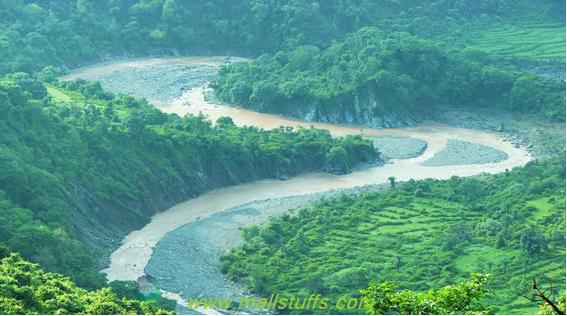
Ghagra river
The present day Ghaggar system originates in the Siwalik range of Himalayan near Ambala, Haryana.
Out of 2,600 sites of the Indus valley civilization, 2000 is found on banks of river saraswati (Presently dried Ghaggar-Hakra) thus making it more appropriate to change Indus valley civilization to saraswati civilization or Saraswati-Indus civilization. This archaeological excavations and scientific research have further concluded that aaryans were indigenous to India and so-called Aryan invasion theory is nonsense and utter false.
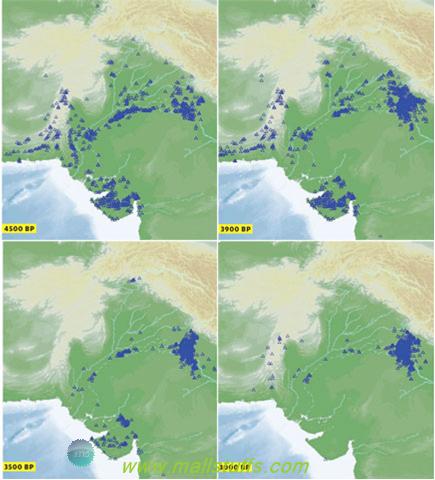
Archeological sites found near Indus valley. As shown above, some 3900 years ago, movement along the hakra-Ghagra route can be seen and around 3,500, the entire route is abandoned with only a few inhabitants surviving near the Indus valley.
In fact, recent excavation revealed that major harrappa settlements were east of river Indus, not west i.e largest concentration of harrapan sites was disceovered along the dry banks of river Saraswati in desert areas of rajasthan and Punjab.
Based on his research on saraswati tiver and regarding saraswati as the root of Hindu civilization, French epigraphist, ‘Coedes' (French 's) said that following the collapsed disapperance of saraswati river, some vedic aryans migrated eastwards to ganges while others migrated southwards to set up the Largest Vishnu Temple in the world (Angkor Wat of cambodia). Naming of the ocean south to India is a significant evidence of prevalence of Vedic religion in all south Asian countries. Indian Ocean in Sanskrit is called as Hind mahasagar (Hind stands for Hinduism and India). This is further supported by various archaeological artifacts found in south Asian countries and confirms the fact that Hindu culture reached all shores of the Indian Ocean rim and extended over 63,000 miles.
After extensive research on Saraswati River, Scientist of Central Arid Zone Research Institute (CAZRI) have confirmed the existence of saraswati river. As per the satellite images, saraswati flowed through the Dry bed of Ghaggar, but changed it course frequently. Senior CAZRI geomorphologist ‘Amal Kar’ confirmed that saraswati river first flowed through the Thar desert, some one million to forty thousands tear ago, passing through Nohar, Surjansar, Sirsa, Lunkanasar and Islamgarh(in Pakistan), Ghantial, Shahgarh(in Jaisalmer), Bikaner, Sakli, and Raini,Ahindi, hakranakra, Mahilamungra (in Pakistan) and Pachpadra where it merges with river ‘Luni’.
Some of the ports on Saraswati River were Lokpat, a major place of education and Narayan Sarovar, a holy place mentioned in Mahabharta.
Field investigations of dried buried courses of ghagra-hakra still yield surface water in the desert region. Further, it is found that the the desert tract of saraswati river supports lush green vegetation even during the hot summer months. Few borewells dugged along the tract yielded sweet water only at 30 to 40 meters which supports the perception that saraswati river flowes underground in the desert tracts of Ghagra-hakra. Saraswati was one of the largest river of India and Sutlej (Whose courses have changed) and Yamuna were its tributaries.
At a place called lothal, a huge port capable of handling huge navigale ships have been excavated. Also, various other objects used in ports like dought nut shaped anchors have been found, thus confirming the external and internal marine trade between nations through river saraswati. Ports are not constructed on any small river and Therefore, saraswati river must be huge, perennial and with large volume of water.
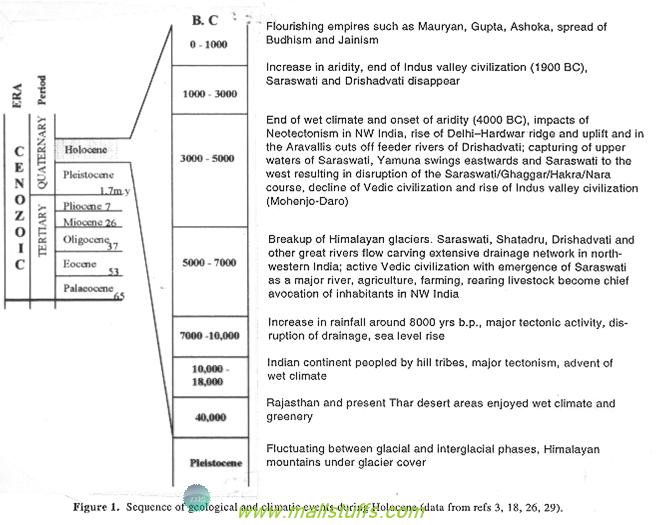
Saraswati - evolution and drainage
Rise of ganga
The disappearance of the Saraswati proved very fatal to the civilization and most of the people thriving on the dry beds migrated southwards and eastwards due to scarcity of water.
Most of the civilization moved east to the fertile plains of river Ganga and south to Godavari plains.
Today the community of saraswati Brahmins is spread all over India right from kaniyakumari in the south to Kashmir in the north, from Kutch in the west to Bengal in the east.
Due to this, many of the haraapan sites were wiped out and most of them settled in the eastern plains of Ganges. This is well supported by later ancient texts like Upanishads. While earliest of text Rig-Veda mention Ganga only twice but saraswati sixty times, later of text like the Upanishads, mention ganges repeatedly without any mention of river saraswati.
Further many archaeological sites with multiple fire altars, used for Sacrifice (Yagna), were found on saraswati banks (Present ghaggar hakra river), at places like Kalibangan of rajasthan
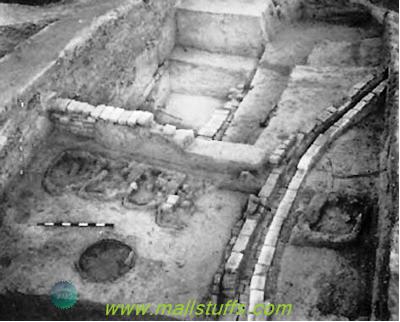
Fire-altars discovered at Kalibangan
We not only have the vast Vedic literature but also 2500 Archaeological site validating the literatures associated with the Indus-Saraswati civilization. So, one can safely assume
Rig Veda to be compiled well before 3000 BCE when Saraswati was in full flow with theVedic AND Harrapan cultures residing near its banks
Our Scriptures were written on the banks of river saraswati, numerous Yagnas were conducted in its vicinity, and the very foundation of Hinduism was laid on the banks of river saraswati. No wonder why the river was worshipped as Bharati , the Mother of indian civilization with the oldest Indian ancient script ‘Brahmi ' singing praise in her apellation,.
Saraswati is indeed the cradle of ancient civilization and so rightly called as
River Dharini, the mother of prosperity.
all Indians must be roud of their rich ancient heritage and must contribute in spreading the awareness of river saraswati as ‘Mother of Indian Culture’.
Below is the starting point of river saraswatik near Mana Gaon, the last village of Indo-tibetian Border. Besides these rocks lies the Bhimpul, which according to Hindu mythology, was formed by Mahabharata character ‘Bhima’ by joining the two massive mountains to make a pathway for Heavan (swarglok)
Note: Images used on this website
are either a production of Bhaktivedanta Book Trust(https://www.krishna.com), Iskcon
Foundation or were found in google search under "Free to use and share". If any
of the images presented here violates copyright issues or infringes anyone copyright
or are not under "Fair use", then please bring it to our notice. Read
Disclaimer for more.
Share this to your friends. One of your friend is
waiting for your share.
Related Articles
Example of historic examples against present caste based system
India most sacred river saraswati found
Caste system in modern india
Why gayatri mantra is the most powerful mantra
Fall and Rise of river saraswati-India most sacred river
Is god female-Yes or No
How Saraswati- india most sacred river disappeared
Chakravyuha-The most deadliest and brilliant military formation
Science in hinduism-Embryology in Bhagavad purana
Why we cannot see god
Post Comment